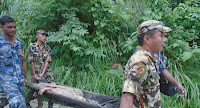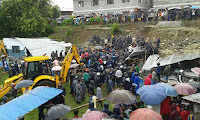At series of landslides have killed at least eleven people in Nepal in the first few days of September 2016. On Friday 2 September a landslide in Taplejung District swept away a house killing its three occupants, Bimilar Magar (28) and her sons, Manoj (9) and Lalit (7), as well as killing a variety of livestock including Cattle, Sheep and Goats. A second incident in the same district destroyed another house with two female occupants; Dil Kumari Palungwa died in the event while her sister Krishna Kumari was seriously imjured and is being treated in hospital. Local sources report at least 75 further homes in the area have been temporarily abandoned due to the fear of further landslips.
The scene of a landslide in Taplejung, Nepal, on Friday 2 September 2016. Kathmandu Post.
On Saturday 3 September two who people died in Bhojpur when a landslide hit their home were identified as Bharat Rai (58) and his wife Rammani (54), while in Myagdi District Om Prassad Bhattachan died when another landslide hit a shed. Another incident in Syangja District led to the deaths of four members of the same family; Chandra Kumari Saru Magar (78) died along with her daughter Hum Kumari Mashrangi (32), granddaughter Punam and grandson Sujan.
All of the incidents have been blamed on torrential rainfall that has fallen across the country in the last few days, with Taplejung receiving 137 mm of rainfall on Friday alone. Landslides
are common during the monsoon season in Nepal, which lasts from May to
September, with the highest rainfall occurring in July. Landslides
are a common problem after severe weather events, as excess pore water
pressure can overcome cohesion in soil and sediments, allowing them to
flow like liquids. Approximately 90% of all landslides are caused by
heavy rainfall.
Monsoons are tropical sea breezes triggered by heating of the land during the warmer part of the year (summer). Both the land and sea are warmed by the Sun, but the land has a lower ability to absorb heat, radiating it back so that the air above landmasses becomes significantly warmer than that over the sea, causing the air above the land to rise and drawing in water from over the sea; since this has also been warmed it carries a high evaporated water content, and brings with it heavy rainfall. In the tropical dry season the situation is reversed, as the air over the land cools more rapidly with the seasons, leading to warmer air over the sea, and thus breezes moving from the shore to the sea (where air is rising more rapidly) and a drying of the climate. This situation is particularly intense in South Asia, due to the presence of the Himalayas. High mountain ranges tend to force winds hitting them upwards, which amplifies the South Asian Summer Monsoon, with higher winds leading to more upward air movement, thus drawing in further air from the sea.
Diagrammatic representation of wind and rainfall patterns in a tropical monsoon climate. Geosciences/University of Arizona.
See also...
 Multiple deaths after landslide pushes bus into ravine in Rasuwa District, Nepal. Thirty-four people are known to have died, twenty five people are being
treated in hospitals and many more people are missing after a landslide
swept a bus into ravine in Rasuwa District, Nepal, on Tuesday...
Multiple deaths after landslide pushes bus into ravine in Rasuwa District, Nepal. Thirty-four people are known to have died, twenty five people are being
treated in hospitals and many more people are missing after a landslide
swept a bus into ravine in Rasuwa District, Nepal, on Tuesday...
Three
people have been confirmed dead after a landslide hit a bus traveling
from Palpa to Butwal on the Siddhartha Highway near Siddhababa...
One
pupil has been confirmed dead and at least 13 more students and
teachers have sustained injuries after a landslide struck a secondary
school...
Follow Sciency Thoughts on Facebook.




